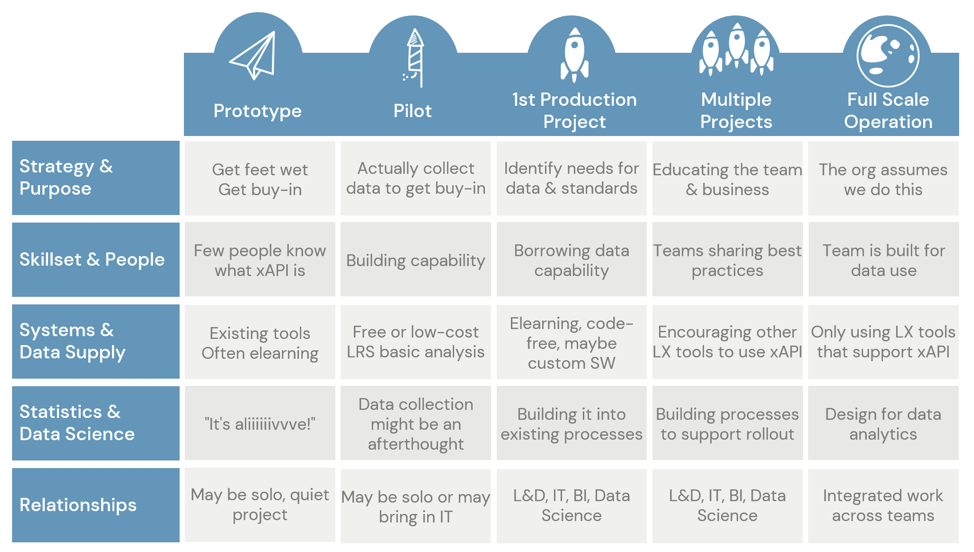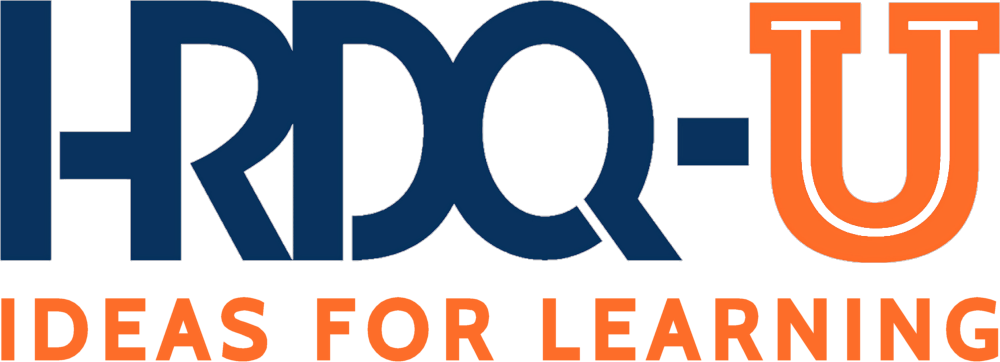We look at maturity across five key dimensions:
Strategy and Purpose: This addresses why the team is taking on a new xAPI project. In the early stages, the goal is simply to learn; in later stages, the goal turns to educating the team and the business. At every step along the way, the work that is done not only serves the immediate project at hand but also builds credibility to take on the next phase of work.
Skillset and People: Here, we are looking at who and how many people know how to use xAPI and to use the data that it creates. In the early phases, we see the skills focused on just one or two people, and in later stages, entire teams are creating and sharing best practices.
Systems and Data Supply: This dimension addresses which tools are being used for the xAPI and data projects. Early on, we see that early projects are often leveraging the team’s existing eLearning authoring tools. There is a critical juncture at the first production project at which it makes sense for the organization to move away from free trial tools and pay for the security that is required when dealing with real employee data.
Statistics and Data Science: As the organization’s maturity advances, the sophistication of the kinds of work that can be done with the data also matures. From the early giddy days of simply seeing data move through the system, we see teams including design for data and analytics in the early planning stages for every project.
Relationships: In this dimension, we are looking at the cross-functional nature of the team that is involved in the innovation efforts around the learning data ecosystem. In the early phases, work may be done as a side or “skunkworks” project. Over time, efforts become more holistic and include IT, data, business intelligence, and other teams.

As you review your own team’s maturity, it’s important to keep in mind that each organization will follow its own path, and few will proceed through this model in a neat step-by-step manner. As such, this is best used as an informative guide rather than a rigid prescription.
Assess Your Organization’s Readiness
This quick assessment will help you identify your organization’s readiness for xAPI and data and analytics across the five dimensions. Use it solo as a guide for yourself, or distribute it among key stakeholders in your organization and see how the differences in your responses can inform your strategy moving forward.
Get Support along the Way
As you and your organization move forward, be sure to tap into industry resources to help make the journey smoother.
Ask Your Vendors for Support: As you engage with them, ask how they support xAPI, data, and analytics. Ask them to see samples and ask them about the data profiles that they use. They should be able to tell you how they’re using xAPI, and this can be a valuable source of insight and learning for you.
Check Your LMS: Many LMSs support the basics of xAPI, recording launches and completions very similar to how they do with SCORM. Some LMSs provide more of the robust interoperability that is promised in the xAPI specification. This free LMS xAPI Tester will help you discover your LMS’s capabilities so that you know what to expect.
Organize Your Projects and Your Data: Once you move beyond eLearning for your xAPI projects, you will want to organize your data profiles so that the data you generate can be useful across projects.
Learn with Your Team!
There are a number of opportunities for learning about xAPI. Free opportunities include xapi.com and the xAPI Learning Cohort. There are free courses on LinkedIn and Udemy, and the Hands-On Learning and Application (HOLA!) course is also available. (Use code HOLA-HRDQ-10 for 10% off when registering.) Complement these courses about xAPI with general business education courses on data and analytics, or the book Data & Analytics for Instructional Designers.





























